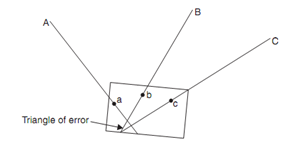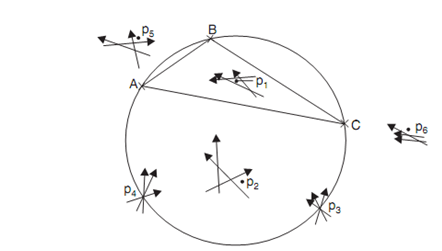Trial and Error Method
This method is also known as 'Lehman's Method' and 'triangle of error method'. It involves the steps which described following:
1. over point P Set the table and just by observation orient the table approximately.
2. Draw the rays aA, bB and cC .If the orientation was ideal, the three rays would have intersected at a single point, for example at point 'p'. Or else a triangle of error is formed.
3. An approximate position, ray p′, is selected near the triangle of error to eliminate the triangle of error. Now keeping alidade along p′a object A is sighted and the table is clamped. Draw the resectors cC and bB to verify the orientation.
4. Above step is repeated until triangle of error is eliminated.

Lehman presented the following guidelines to choose 'p′' so that triangle of error is eliminated rapidly.
Rule 1: from the corresponding rays the distance of point sought 'p' is in the same proportion as the distance of those from the plane table station.
Rule 2: The point sought 'p' is on the same side of all the 3 resectors.
Defining the triangle ABC on the field as great triangle and as great circle, the circle is passing through them. From the above 2 rules of Lehman, the following sub-rules can be drawn as shown in figure.

- If within the great triangle 'P' lies, the point 'p' is within the triangle of error (p1 in the).
- If the plane table station P lies outside the great triangle the point sought 'p' is outside the triangle of errors (p2).
- If 'P' is lie on the great circle, the accurate solution is impossible (p3 and p4).
- If 'P' is outside the great circle, 'p' is nearer to the intersection of rays to the nearest 2 points (P5).
- If point P is outside the great circle and the 2 rays drawn are parallel to each other the point sought is outside the parallel lines and on the similar side of the 3 rays (P6).